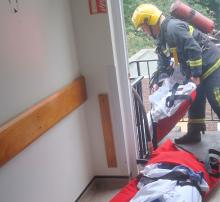Organising Evacuation of Dependent Individuals in the Event of a Fire
Organising Evacuation of Dependent Individuals in the Event of a Fire
There is no simple way to know how long it will take a person with mobility impairments, or a highly dependent person, to evacuate or be evacuated from a building before conditions become untenable because of fire.
Coordinating the various aspects of a fire evacuation strategy falls on the fire safety manager or management team. They are responsible for making sure these aspects of the strategy work together efficiently and effectively. This is especially true when the occupants’ dependency and the design features of a building require those in the building to be aware of the necessary actions in the event of a fire, and possibly be involved in ensuring that those actions are taken.
Fire safety management
When organising an evacuation that includes people with mobility impairments, effective fire safety management should ensure that sufficient people with relevant training are available for any evacuation situation. They will be aware of the most effective methods for evacuating people, and of the most efficient order in which to carry out the evacuation.
Another important factor in considering the most effective method of evacuation is that staff members who interact with people with mental impairments, children or the elderly on a regular basis will know how to achieve an efficient evacuation without causing undue distress to individuals. Keeping evacuees calm can be crucial in avoiding lost time due to evacuees’ resisting help or becoming lost in the building.
People managing evacuations may wish to take measures such as separating evacuators into two groups; one dealing with the preparation of mobility-impaired people, the other dealing with getting those people out. The decisions that need to be taken will vary from one situation to another, an effective fire safety manager will be familiar with the needs of the occupants of the building for which they are responsible and will, therefore, have sufficient information with which to make these decisions.
Fire safety managers are responsible for organising the training of staff on the evacuation of people with mobility impairments. Training should include understanding the systems installed in the premises, and instruction on suitable techniques and strategies for carrying out evacuations. Research shows that drills are essential if staff members are to evacuate those occupants of a building who cannot evacuate themselves, efficiently, quickly and safely. Drills can be carried out safely if prior consideration is given to manual handling and infection control.
A successful fire safety plan, capable of satisfying the requirements of the Fire Safety Order 2005, will need to include an evacuation plan that ensures the safety of those at risk from fire. This will be most effectively achieved through consultation with all the people involved in undertaking the evacuation.
Role of front-line staff
Staff members responsible for the day-to-day care of people with mobility impairments are most likely to be physically involved in assisting an evacuation, should it be required. They will also be able to provide useful information on which techniques are likely to succeed in achieving successful evacuation. They will be most familiar with evacuees’ requirements, and will, therefore, be able to evaluate how best to evacuate them from the building, and how much time and help will be needed.
Patients in acute healthcare premises may be attached to one or several pieces of equipment as part of their treatment or life support. Front-line staff should be consulted on whether a person can be disconnected from any of this equipment, and for how long. Plans for ensuring continuity of care are vital, particularly for patients on life support.
Acute care staff will already have plans and techniques in place for moving patients during normal circumstances and in the event of power cuts, equipment failures or medical emergencies. Therefore staff can use the skills and knowledge that they already possess to help expedite evacuation in the event of a fire.
Further research
A research programme commissioned by the BRE Trust considers the means of evacuating people who are elderly or ill, or children, from buildings – residential care, healthcare and domestic premises. The findings from this research are included in a new guide, which aims to provide support for designers, owners and managers of buildings so that they can formulate efficient strategies for the effective evacuation of people with mobility impairments.
‘Evacuating vulnerable and dependent people from buildings in an emergency’ will be available from www.brebookshop.com from August 2012.

